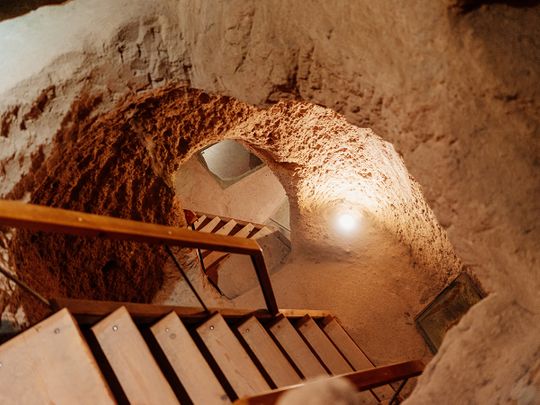
The cupboard door that opened to Narnia may have been fiction. But a man experienced something similar in Turkey, when he tore down the wall of his basement in a home renovation project, and uncovered a sprawling, ancient underground city.
Click start to play today’s Spell It, where a ‘prod’ in the right direction helped reveal a subterranean metropolis.
In 1963, a man in the Turkish town of Derinkuyu got more than he bargained for, when he swung a sledgehammer to the wall and found there existed a tunnel right behind it. That tunnel led to more and more tunnels, until it transformed into a massive underground complex, connected by hundreds of halls and chambers.
According to the US-based multimedia website Big Think, archaeologists later ascertained that the vast city of Derinkuyu stretched 18 stories into the earth – 76m deep – and was large enough to accommodate 20,000 people.
Located in Cappadocia, which is known for its craggy landscape and fairy chimneys, Derinkuyu’s subterranean complex is not the first underground labyrinth to be found in the region. But it remains the largest and most famous one.
But who made it? How and why?
The answers are not very clear. Historians speculate that the oldest part of the complex could have been dug in about 2000BC by Hittites – people who dominated the region at the time. Or, it could have been built by Phrygians in 700BC, who were an ancient Indo-European speaking people.
Regardless of who built it, it’s clear that they had remarkable skill. The soft rock in Cappadocia makes for easy tunnelling and digging, but the biggest challenge the builders would have had to face is cave-ins. Large support pillars would have been necessary to achieve the task. The amazing thing is, despite the march of time, Derinkuyu’s complex has never collapsed! It’s a testament to the builders’ skill and knowledge of construction systems.
The ancient city’s ventilation system is another marvel. Even though the city was shut off from the world, it comprised over 15,000 shafts that were about 10cm wide and reached down into the first and second levels of the city – the residential floors – and provided enough ventilation down to the eighth level. The lowest levels were mostly used for storage and there was even a dungeon. In between were a number of multi-functional spaces, from convents to pens for domestic animals.
In a region that experienced extremely hot summers and frosty winters, Derinkuyu’s complex maintained an ideal moderate temperature. It was self-sufficient, thanks to some shafts that went deep into the ground and doubled as wells, allowing residents to get their water through buckets passed down through various levels.
It might be why this massive subterranean city was known as Derinkuyu, which means ‘deep well’ in Turkish.
Historians believe the city was a refuge for the local population during the wars between the Byzantines and Arabs, which lasted from the late 8th to 12th centuries. It was also used during the Mongol raids in the 14th century.
Today, Derinkuyu is a major tourist attraction in Cappadocia, drawing in millions of tourists from around the world. It just goes to show – you never know what you might find on the other side of the wall.
Have you been to Derinkuyu? Play today’s Spell It and tell us at games@gulfnews.com.




